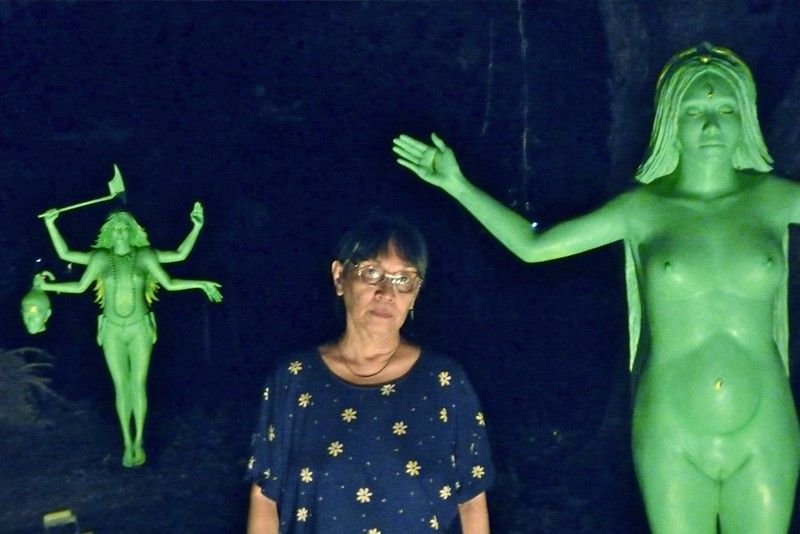Editions of the sacred feminine


Attending a social at UP Diliman last week, I found myself fortunate to espy an intriguing new sculptural installation among the trees beside the Vargas Museum, The four female figures in verdigris blended well with the greenery, even as they dominated the knoll that rose by the driveway. They turned out to be part of a tripartite public art project billed as “Lawas” (meaning Body), curated by UP Department of Art Studies faculty Tessa Maria Guazon and Cecilia De la Paz. “Lawas” was publicly launched last Wednesday. It will be on view until end of August, with a series of events to be organized until that month, starting in June.
I didn’t get to attend the walk-through at the launch date, thus missed out on the unveiling of two of the components: Mark Justiniani’s “Pusod” at the UP Lagoon, and Lee Paje’s “Pagpamulak” which is also situated near the museum. The third, which I was lucky to preview, was my dear old friend Agnes Arellano’s “Pleiades.”
What the three art projects — a feature of the 2018 UP Diliman Festival of Culture and the Arts — have in common is that they “explore the intricate process of dwelling the body,” or probing its limits.
“Pagpamulak” (meaning “to blossom”) is “a playground of intimate forms” that take off from Paje’s 2011 series where vagina-shaped chocolates were filled with tapuy (rice wine) and eaten during the exhibition. The updated edition invites viewers to “play with the stylized sculptures that mimic the body’s intimate parts.”
For his part, Justiniani has created a reflective disk as a navel that “rests on earth and reflects the skies above,” thus serving as an “invisible umbilical cord between heaven and earth.” At daytime, clouds come close enough to touch, while at sundown, a deep crater is revealed.
Arellano’s “Pleiades” gathers cast stone goddesses in a grove, four of them, out of the seven in the familiar star cluster seen by the naked eye at night.
I managed to interview Agnes about her work. She explains that the figures she’s sculpted are based on her continuing study of ancient religions and myths, as part of lifelong research on the female principle in religion: a search for the Sacred Feminine. Using body casts of her own naked body to delve into comparative mythology and archetypal symbols, she depicts the celestial beings with their arms in epiphany position. These are:

The “Pleiades” public art project at a grove in UP Diliman, featuring four mythical goddesses — with Innana up front, the tallest at 6’6’’
Dakini — Tantric sky goddess, the female embodiment of enlightenment. “Her right hand holds a vajra scimitar for cutting off defilements, while on her left is a skull bowl that dispenses wisdom and blessings instead of transgressive fluids.”
Innana — a cow goddess with bovine hooves, the horns of a tamaraw, and three pairs of breasts, reminiscent of an earlier fantasy self-portrait after the Manobo myth of Mebuyan, Goddess of the Underworld, who nourishes all children who die at childbirth. “Her right hand clasps a Sacred Knot, symbol of fertility, while her left holds a conch shell, to evoke Sound, which is the beginning of all Life.”
Kali — the Hindu goddess of Time, Death and Destruction, portrayed not with her usual protruding tongue, but with bloodthirsty fangs. “She has four arms: the upper right arm carries an axe, fashioned after a replica used for headhunting in the Kalinga tribe of the Cordilleras; on the opposite side, the upper left arm is held high with the mudra or hand gesture that says ‘Fear Not.’ The lower right hand holds the severed head of a warrior, one of the many killed in her rampage, while on the lower left arm appears the gesture of Generosity, or the bestowing of blessings.”
Magdalene — “Christ’s most beloved disciple, who is said to have come from Egypt, where she attained an advanced level of priesthood. She is Isis reborn, symbolized by a serpent on her cranial protruberance. As she’s depicted here, the Magdalene is with child, while on her palms and feet are the scars of the crucifixion.”
Dakini was the first to be done, reassembled with old and new casts from a show some years back at Mo Space, when it was titled “Flying Dakini” since she was suspended from the gallery ceiling.
As that figure was previously a relief, Agnes had to build up her whole back by direct modelling in plaster, using the semi-liquid plaster like clay. With a special exhibition grant for the recent Art Fair, she worked for six months with plaster of Paris — live-casting new arms and body parts and combining these with direct modelling to reassemble into new forms. One final rubber mold produced this edition in cast stone, which was stained with tea. Dakini became upright, as were the other three figures.
For “Lawas,” it took another three months for the figures to stripped of tea, sanded for a finer finish, then waxed with several coats of verdigris. Highlights were in emerald craypas and gold wax.
With her horns and hooves, Inanna now stands at 6’6”. Dakini is 6’1” while Kali and Magdalene are both 6’3” in height.
Agnes says: “Project Pleaides hopes to reawaken the Sacred Feminine in all of us. The goddesses are here to help us recall ancient values of nurturing, inclusivity, generosity, compassion and caring. In truth, there is only one Goddess, and She has many forms.”


















